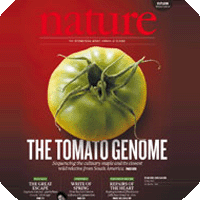Research Focus |
|
番茄基因组序列研究有助于肉质果实的进化研究 2013-01-17 17:06:49 浏览次数:2413 | |
| 番茄基因组序列研究有助于肉质果实的进化研究 来源:仪方生物 www.yeslab.com 西红柿基因组协会 西红柿(Solanum lycopersicum)是一种主要的农作物和果实发育的模式系统。Solanum也是目前最大的被子植物属,存在于多种栖息地的一年生和多年生植物。研究小组通过对种植番茄(一种野生种的近缘种)和Solanum pimpinellifolium进行高质量测序及绘制草图,并将两者相互比较,以及同土豆(Solanum tuberosum)比对。这两种番茄基因组仅有0.6%的差异性核苷酸和近缘混合性,但与土豆超过8%的差异,有9个大的和几个小的倒置区。与拟南芥相反,但是类似大豆,番茄和土豆小RNA图谱主要以富含基因的染色体区域,包括基因启动子。Solanum系具有2个连续基因组3重复,一个是祖序列,一个共享rosids和一个更近序列。这些三重复序列为控制果实特性例如颜色和果肉的新功能化基因提供基础。 The tomato genome sequence provides insights into fleshy fruit evolution The Tomato Genome Consortium* Tomato (Solanum lycopersicum) is a major crop plant and a model system for fruit development. Solanum is one of the largest angiosperm genera and includes annual and perennial plants from diverse habitats. Here we present a high-quality genome sequence of domesticated tomato, a draft sequence of its closest wild relative, Solanum pimpinellifolium, and compare them to each other and to the potato genome (Solanum tuberosum). The two tomato genomes show only 0.6% nucleotide divergence and signs of recent admixture, but show more than 8% divergence from potato, with nine large and several smaller inversions. In contrast to Arabidopsis, but similar to soybean, tomato and potato small RNAs map predominantly to gene-rich chromosomal regions, including gene promoters. The Solanum lineage has experienced two consecutive genome triplications: one that is ancient and shared with rosids, and a more recent one. These triplications set the stage for the neofunctionalization of genes controlling fruit characteristics, such as colour and fleshiness. |
